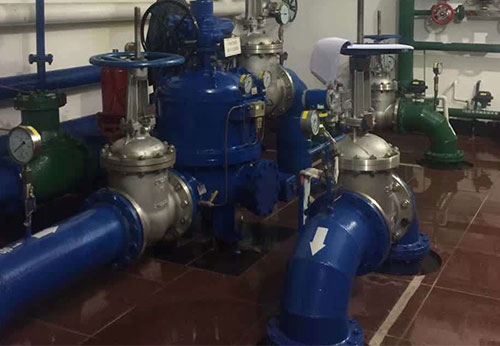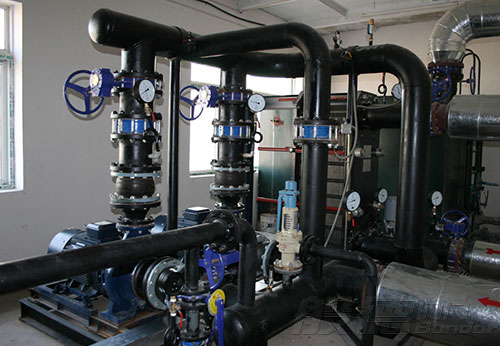There are several connect types for the valve
Posted by Bundor valve
As a valve buyer, you should often be asked whether you want a wafer type or a flange type, and so on. These questions about valve connection types, so do you know how many connection types ?
1. Flange connection

Flange connection is the most commonly used connection type between valve and pipeline or equipment. It refers to a detachable connection in which a flange, a gasket and a bolt are connected to each other as a set of combined sealing structures.
Pipe flange refers to the flange used for piping in the pipeline installation, and used on equipment refers to the inlet and outlet flanges of the equipment. Flange connection is easy to use and can withstand greater pressure.
Flange connection can be applied to valves of various nominal sizes and nominal pressures, but there are certain restrictions on the operating temperature. In high temperature conditions, the connection bolts of the flange are prone to creep and cause leakage. The blue connection is recommended to be used at a temperature of ≤350℃.
2.The wafer connection

The connection type in which the valve and the two pipes are directly clipped together with bolts.
3. Welding connection
Welded connection refers to a type of connection in which the valve body has a welding groove and is connected to the piping system by welding.
The welding connection between the valve and the pipeline is divided into butt welding connection (BW) and socket welding connection (SW). Butt welding connection (BW) can be applied to various sizes, pressures and high temperature conditions. SW) is generally applicable to valves of ≤DN50.
4. Threaded connection
An easy connection type, often used for small valves. There are two cases:
Direct sealing: The inner and outer threads directly play a sealing role. In order to ensure that the connection does not leak, it is often filled with lead oil, thread hemp and PTFE raw material tape, among which PTFE raw material tape is widely used.
Indirect sealing: The force of thread tightening is transmitted to the gaskets on the two planes, so that the gaskets play a sealing role.
5. Card sleeve connection
The working principle of the ferrule connection is that when the nut is tightened, the ferrule is under pressure, so that the edge of the ferrule bites into the outer wall of the pipe, and the outer cone surface of the ferrule is in close contact with the inner cone surface of the joint under pressure, so it can reliably prevent leakage . At present, the ferrule connection type has been adopted in some small-diameter valve products in my country.
6. Clamp connection
This is a quick connect type that requires only two bolts and is suitable for low pressure valves that are frequently disassembled.
7. Internal self-tightening connection
Internal self-tightening connection is a type of self-tightening connection using medium pressure. Its sealing ring is installed at the inner cone and forms a certain angle with the side facing the medium. The pressure of the medium is transmitted to the inner cone and then to the sealing ring. On the cone surface of a certain angle, two component forces are generated, one with The center-line of the valve body is parallel to the outside, and the other is pressed against the inner wall of the valve body.
The latter force is the self-tightening force. The greater the medium pressure, the greater the self-tightening force. Therefore, this connection form is suitable for high pressure valves. Compared with flange connection, it saves a lot of material and manpower, but it also requires a certain preload, so that it can be used reliably when the pressure in the valve is not high.
There are many other valve connection types, for example, some small valves that do not need to be removed are welded together with the pipe; some non-metallic valves are connected by socket and socket, and so on.
Different connection types of the valve are suitable for different working conditions and environments, and the valve user should treat it according to the specific situation.
1. Flange connection

Flange connection is the most commonly used connection type between valve and pipeline or equipment. It refers to a detachable connection in which a flange, a gasket and a bolt are connected to each other as a set of combined sealing structures.
Pipe flange refers to the flange used for piping in the pipeline installation, and used on equipment refers to the inlet and outlet flanges of the equipment. Flange connection is easy to use and can withstand greater pressure.
Flange connection can be applied to valves of various nominal sizes and nominal pressures, but there are certain restrictions on the operating temperature. In high temperature conditions, the connection bolts of the flange are prone to creep and cause leakage. The blue connection is recommended to be used at a temperature of ≤350℃.
2.The wafer connection

The connection type in which the valve and the two pipes are directly clipped together with bolts.
3. Welding connection
Welded connection refers to a type of connection in which the valve body has a welding groove and is connected to the piping system by welding.
The welding connection between the valve and the pipeline is divided into butt welding connection (BW) and socket welding connection (SW). Butt welding connection (BW) can be applied to various sizes, pressures and high temperature conditions. SW) is generally applicable to valves of ≤DN50.
4. Threaded connection
An easy connection type, often used for small valves. There are two cases:
Direct sealing: The inner and outer threads directly play a sealing role. In order to ensure that the connection does not leak, it is often filled with lead oil, thread hemp and PTFE raw material tape, among which PTFE raw material tape is widely used.
Indirect sealing: The force of thread tightening is transmitted to the gaskets on the two planes, so that the gaskets play a sealing role.
5. Card sleeve connection
The working principle of the ferrule connection is that when the nut is tightened, the ferrule is under pressure, so that the edge of the ferrule bites into the outer wall of the pipe, and the outer cone surface of the ferrule is in close contact with the inner cone surface of the joint under pressure, so it can reliably prevent leakage . At present, the ferrule connection type has been adopted in some small-diameter valve products in my country.
6. Clamp connection
This is a quick connect type that requires only two bolts and is suitable for low pressure valves that are frequently disassembled.
7. Internal self-tightening connection
Internal self-tightening connection is a type of self-tightening connection using medium pressure. Its sealing ring is installed at the inner cone and forms a certain angle with the side facing the medium. The pressure of the medium is transmitted to the inner cone and then to the sealing ring. On the cone surface of a certain angle, two component forces are generated, one with The center-line of the valve body is parallel to the outside, and the other is pressed against the inner wall of the valve body.
The latter force is the self-tightening force. The greater the medium pressure, the greater the self-tightening force. Therefore, this connection form is suitable for high pressure valves. Compared with flange connection, it saves a lot of material and manpower, but it also requires a certain preload, so that it can be used reliably when the pressure in the valve is not high.
There are many other valve connection types, for example, some small valves that do not need to be removed are welded together with the pipe; some non-metallic valves are connected by socket and socket, and so on.
Different connection types of the valve are suitable for different working conditions and environments, and the valve user should treat it according to the specific situation.
 简体中文
简体中文 Русский
Русский Español
Español Bundor - Butterfly, Gate, Check, Ball, Globe Valve Manufacturer, Supplier & Distributor
Bundor - Butterfly, Gate, Check, Ball, Globe Valve Manufacturer, Supplier & Distributor
